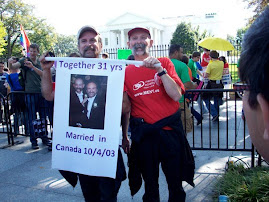For Slain Youth, World Wide Web Of Mourners - washingtonpost.com
By Jose Antonio Vargas
Washington Post Staff Writer
Thursday, April 3, 2008; Page C01
No one really dies on the Internet. A private life becomes public. Every life finds an audience. Look at Lawrence "Larry" King. The openly gay eighth-grader who was shot and killed nearly two months ago lives on.
Larry lives on Wikipedia, where we learn about his tense life at school, the name-calling, the taunts, the teasing. Larry lives on Facebook, MySpace and YouTube, where he's mourned by strangers not willing to let go. Larry lives on Web sites where the 15-year-old's photos -- Larry in front of the White House, Larry on ice skates, Larry getting a haircut -- stare back at us, as if incarnated. Alive.
The Internet, so vibrant, so potent, brings those attributes to the dead, immortalizing them in unexpected new ways. Where once there would have only been a candlelight vigil outside Larry's house or school in Southern California, now there's also a virtual vigil in real time that knows no geographic bounds. Where once people would have attended a memorial service and cried about Larry's sad story, now they can also bear witness and become the sad story's messenger -- virally.
Sherry Turkle, a Massachusetts Institute of Technology professor and the author of "Life on the Screen," says the online reaction to Larry shows "the other side of the Internet.
"When people talk about the Internet, people usually say, 'You can have your own blog, you can be Matt Drudge, you can start your own business,' " Turkle says. "What's going on with Larry is the flip side of all that. Things happen to other people and we don't often have a way to express how we're personally touched. 'There but for the grace of God go I .' The Internet allows us to express that connection. What were once private connections are now made public, but they're no less intimate."
Here's what we know: At E.O. Green Junior High School in Oxnard, Calif., Larry wore purple eye shadow, pink lipstick and high-heeled boots. And Larry reportedly told Brandon McInerney, 14, a member of the Young Marines program, that he liked him. Then, on the morning of Feb. 12, during English class, Brandon allegedly walked into the computer lab with a handgun and shot Larry in the back of the head.
Larry's death -- reminiscent of the murders of Matthew Shepard in 1998 and Eddie Araujo in 2002, both also gay -- was inadequately covered by the mainstream media, gay rights activists say.
Gay blogs such as Page One Q, Pam's House Blend and Bilerico, in addition to an e-mail list of the who's who of national gay rights leaders, were instrumental in getting the story out. The Advocate, the bimonthly gay newsmagazine, splashed the story on its cover under the headline: "Who's to Blame? We told Lawrence King he had the right to express his sexuality. Did we send him to his death?" Inside the magazine was a first-person essay of a pregnant transgender man; associate editor Neal Broverman says the mainstream was far more interested in the transgender story than in the shooting.
Newspapers took several days, if not weeks, to cover Larry's story.
Nevertheless, Larry is immortalized on the Web. Google, after all, doesn't forget. RememberingLawrence.org, sponsored by the Gay, Lesbian and Straight Education Network, shouldn't be confused with RememberLarry.com, put up by the slain teen's family. (The Kings declined to comment for this story.)
A Wikipedia entry on "E.O. Green school shooting" was born hours after Larry was shot; Danny Chia, 22, a student at University of California, Berkeley, has edited the entry at least four times.
A 21-year-old on MySpace changed the headline on her profile to "R.I.P. Larry King" and posted a photo of Larry reclining on an airplane seat. On Facebook, more than 15 groups honoring Larry have been created in the past few weeks, including one called "I am not a second-class citizen," which lists 10,002 members, and another called "Remembering Lawrence King (Murdered Because He was Gay)" with more than 90,000 members.
And on YouTube, type "Lawrence King" and dozens of videos pop up, many responding to the two-minute video of Ellen DeGeneres's remarks on her talk show, viewed more than 350,000 times on her YouTube channel. One video is a five-minute mash-up of Larry's photos with audio of the 911 call on the morning of the shooting set to the Culture Club song "Do You Really Want to Hurt Me?"
Says Joshua Porter Zeller, a 17-year-old junior at Trinity Catholic High School in St. Louis: "If it wasn't for the Internet, I wouldn't have known about what happened to Larry. I have a religion class. In freshman year, the class was about church history. This year the first semester was on the New Testament, and right now the second semester is on morality. I asked my teacher if were going to talk about Larry's shooting. He said no."
Zeller, who is straight, is helping organize a "Day of Silence" in the school's cafeteria on April 24. He also started a Facebook group a few weeks ago. It now has 169 members, mostly strangers.
Thursday, April 3, 2008
For Slain Youth, World Wide Web Of Mourners - washingtonpost.com
Subscribe to:
Post Comments (Atom)


No comments:
Post a Comment